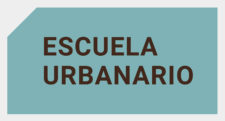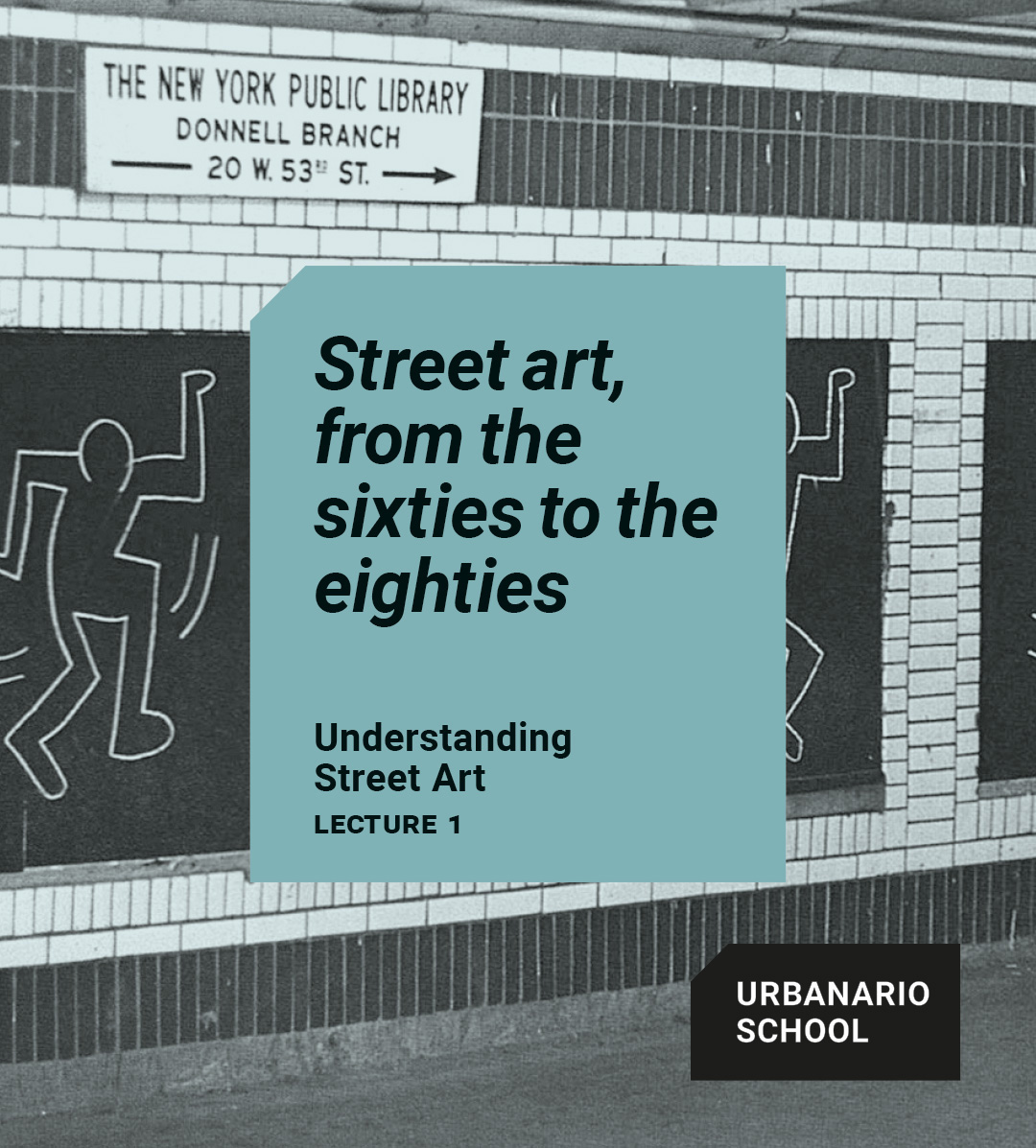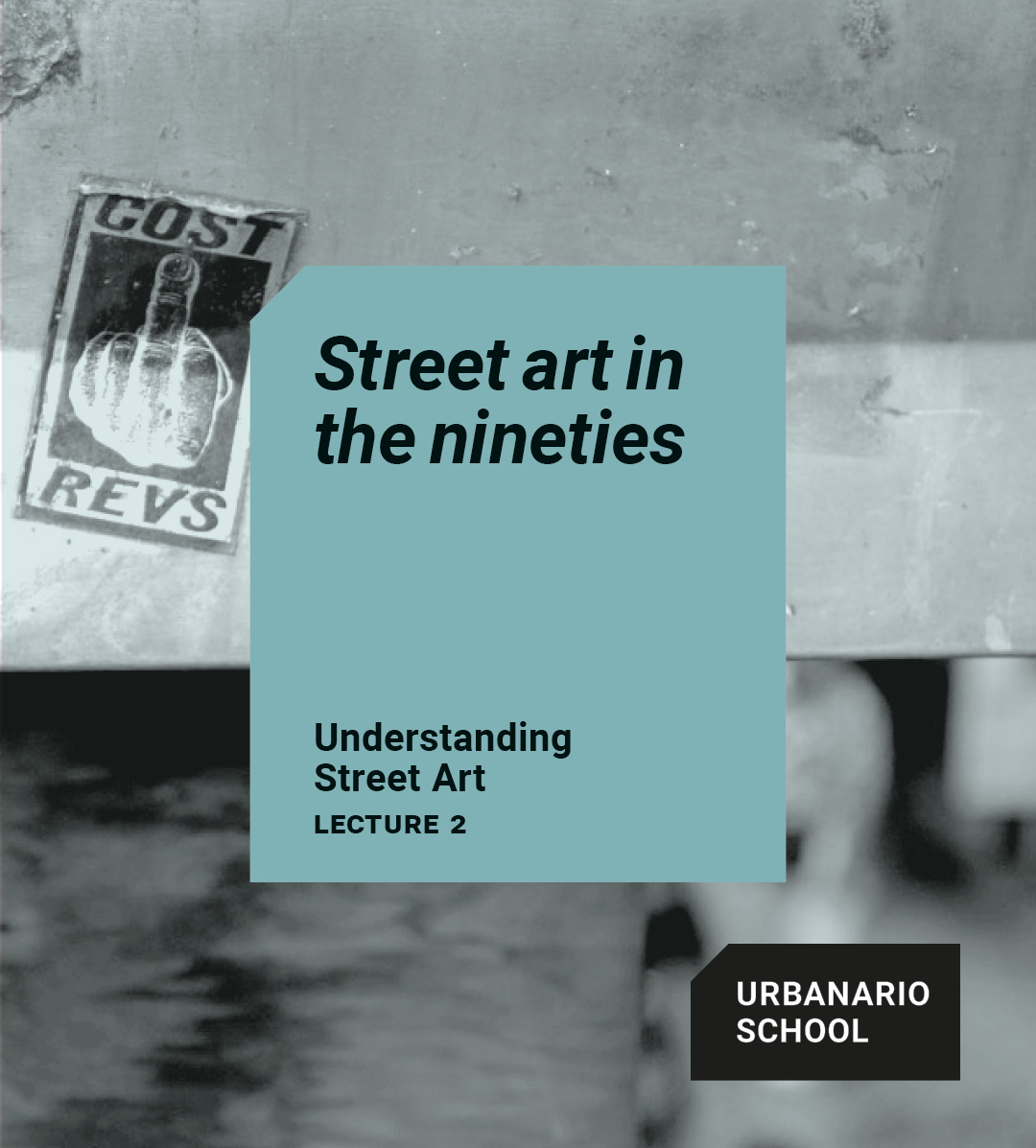UNDERSTANDING STREET ART
July 1–29, 2021
Online course
Teacher: Javier Abarca
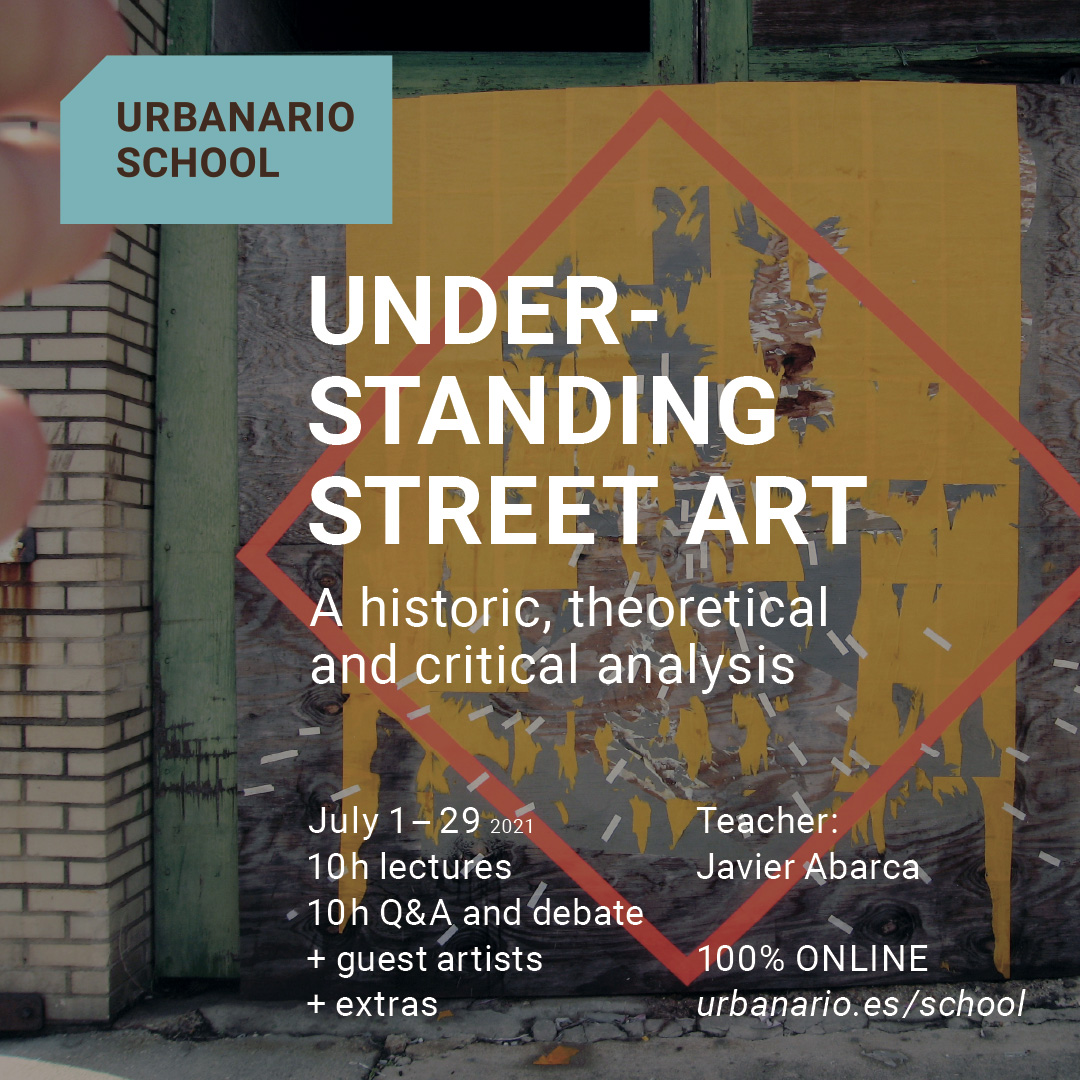
Understanding Street Art is a four-week online course offering a detailed exploration of street art, from the humblest interventions to the large-scale murals. It studies its history in depth, dissects its inner workings as an art practice, and lays out an incisive critical analysis of its politics.
The course is designed and taught by Javier Abarca, one of the leading thinkers in the field, with 15 years of experience teaching these topics internationally at university level. The program features Q&A sessions with guest artists and other extras.
Guest artists:
Eltono (FR)
MOMO (US)
Lectures are freely streamable, and the main scheduled events take 2 hours per week. You retain access to all lectures and recordings of live events after the course ends.
Taught in English.
This course offers the following content:
- A detailed analysis of the diverse and interrelated practices of street art. From serial postering to site-specific interventions, from inconspicuous comments to invasive declarations, from furtive, human-scale artworks to institutional murals.
- An in-depth look into the history of street art. Its revealingly close prefigurations of the 60's and 70's, the intense but short-lived hype of the 80's, the lone visionary projects of the 90's, and the blossoming and eventual co-optation of the practice in the 21st century.
- A dissection of the hidden inner workings that make furtive street art unique as an art practice. With a focus on its contextual and temporal dimensions, its spatial strategies, and the relation of the artworks with the scale of the human body.
- An examination of the evolving tastes and audiences of the street art scene. From cute and simple characters, to sentimental handcrafted portraits, to sophisticated abstractions and interventions. From catering to young, graffiti-influenced fans to attracting growingly adult and art-educated profiles.
- An incisive critical analysis of the politics of street art, and of the paradoxical ways street and society intertwine. With a focus on practices such as artivism and 'buff' art, key issues such as appropriation and gentrification, and the problematic transition from the street to the gallery.
Methodology
Video-lectures you can stream freely
Ten hours of dynamic, immersive and carefully illustrated content, featuring exclusive and unpublished images
Weekly seminars
Thursdays 6–8pm (GMT+1)
Q&A and discussion with the teacher on Zoom
Each seminar explores one lecture from the program
Guest artists
Q&A sessions on Zoom
Eltono (FR) | July 5 (monday) 6–8pm (GMT+1)
MOMO (US) | July 26 (monday) 6–8pm (GMT+1)
Weekly watch parties
Fridays 6pm (GMT+1)
Discover lesser-known treasures with friends and a chat
Thematic chats on Telegram
Share and discuss information with other street art enthusiasts
Permanent access
You retain access to lectures and recordings of live events after the course ends
One-to-one mentoring sessions
Booked separately
THE COURSE INCLUDES:
- Ten hours of lectures
- Ten hours of seminars
- Two guest artists
- Weekly watch parties
- Telegram chats
- Permanent access
- Certificate
Upcoming enrollment:
October 2021
¡ÚLTIMAS PLAZAS!
20% descuento
estudiantes y desempleados
SÓLO 150€
Envíanos tu email y te escribiremos
About the teacher

Javier Abarca (Madrid 1973) is one of the leading thinkers in the field of graffiti and street art. A key artist in the first generation of Spanish graffiti, he taught a pioneering 4-month course on these topics at the Complutense University of Madrid between 2006 and 2015. He works internationally as an educator, researcher and author.
After teaching widely for 15 years, Abarca founded the Urbanario School, an online academy for advanced education about graffiti, street art and related topics. Since 2008 he has run the website Urbanario, the essential source for graffiti and street art research in Spanish language. He is also the founder and director of the groundbreaking events Unlock Book Fair and Tag Conference.
PROGRAM
Lecture 1
STREET ART, FROM THE 60’S TO THE 80’S
In the 60’s, tactics such as performance or land art allowed artists to break free from the conventions of art.
This same urge brought about experiments we now would call street art. Most approaches and techniques of street art were explored by artists in the 60’s and 70’s.
Street art as a movement took shape in the 80’s, from the convergence of contemporary art with advertising, graffiti and punk.
Lecture 2
STREET ART IN THE NINETIES
The popularity of street art waned in the late 80’s, and most local scenes vanished with it.
The 90’s saw little activity in general. The two main exceptions were Revs and Shepard Fairey, two very different but equally influential artists.
The monumental and visionary work developed by Revs and Fairey in the nineties laid the first foundations of what street art would become in the next decade.
Lecture 3
THE STREET ART DECADE: 2000-2010
By the start of the 21st century, the internet resurrected street art, now as a closely connected global scene.
This lecture examines the keys to understanding street art in its blossoming years. Its techniques, its ethics, its shifting tastes and audiences, and its difficult relation with graffiti.
Also its strategies, from quasi-advertising campaigns to site-specific interventions, from inconspicuous pieces to large works painted with pole and roller.
Lecture 4
FROM STREET ART TO MURALS, WHAT HAVE WE LOST?
The irruption of institutional murals in the 2010’s caused a radical shift in the idea of ‘street art’. Smaller, ephemeral works lost their prominence in the collective imaginary, blinded by the impact of monumental formats.
This lecture makes use of this contrast to discover and study the hidden mechanisms that make uncommissioned street art a unique art form. In particular its contextual and temporal dimensions, and its relation with human scale.
Lecture 5
THE POLITICS OF STREET ART
Street art and society interrelate in paradoxical ways. Street art operates in a limbo between activism and advertising. Society represses street art with one hand and exploits it with the other.
This lecture covers the main topics studied in our course “Street Art, Society and Politics”. Surprising practices such as artivism and ‘buff’ art, thorny issues such as appropriation and gentrification, and the problematic transition from the street to the gallery.
OUR GUESTS ARTISTS
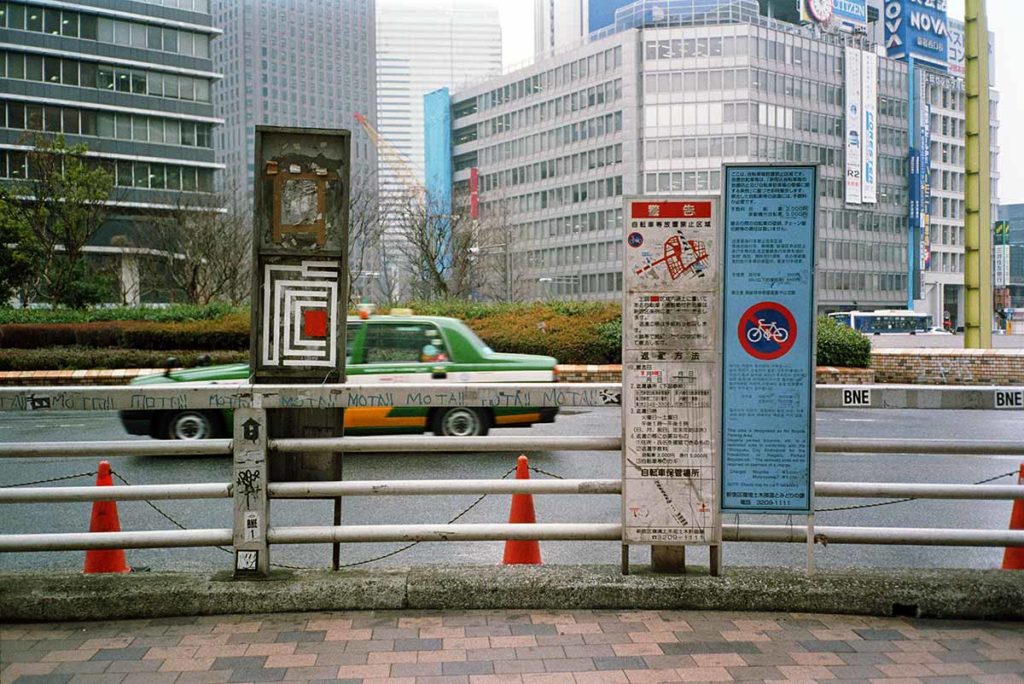
Eltono (FR)
July 5 (monday)
6–8pm (GMT+1)
Eltono was one of the earliest instigators of today’s street art, and has become a key figure for understanding the transition to murals and galleries. Through two decades of work he patiently built his own audience, and his contributions towards the maturation of the practice are difficult to overestimate.
In our meeting with Eltono we will look into his lesser-known foundational work, and learn about the concepts he works with today. Javier Abarca has had privileged access to Eltono’s processes since the late 90’s, and has worked with him as a curator in groundbreaking museum exhibitions.
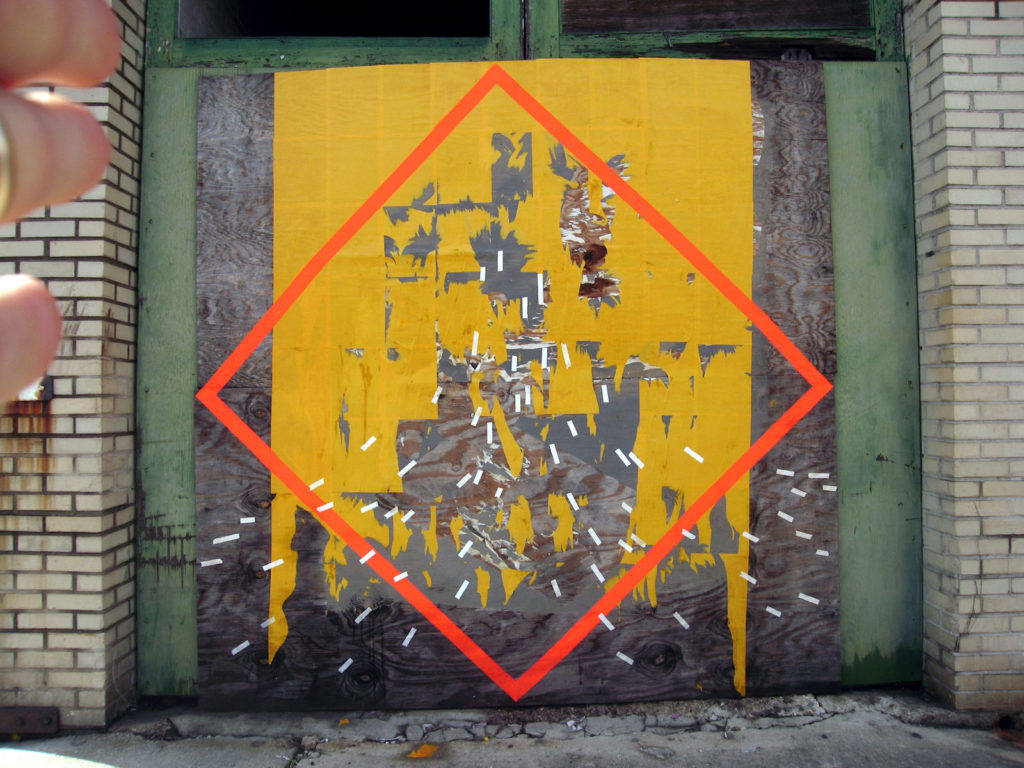
MOMO (US)
July 26 (monday)
6–8pm (GMT+1)
MOMO is probably the most underrated American street artist. Always years ahead of the scene, he is known as the key figure in the introduction of abstraction as a standard language.
In his abstract approaches of the mid-2000’s MOMO found that sweet spot between accessibility and depth of reading only the most relevant street art projects hit. Yet the work came too early and found scarce public.
Over the years, awareness and appreciation of his figure has consistently grown, and he has progressively focused on ever-more sophisticated studio and mural work.
In our meeting with MOMO we will look into his practice and discover surprising, unpublished work from two decades ago. Javier Abarca has worked with MOMO in books and exhibitions since 2010.
CALENDAR
SEMINARS
Seminar 1
Thursday July 1
6–8pm (GMT+1)
Introduction to the course and discussion of the lecture “Street Art, From the 60’s to the 80’s”. You will get access to the lecture one week before the course starts.
Seminar 2
Thursday July 8
6–8pm (GMT+1)
Discussion of the lecture “Street Art in the Nineties”.
Seminar 3
Thursday July 15
6–8pm (GMT+1)
Discussion of the lecture “The Decade of Street Art: 2000–2010”.
Seminar 4
Thursday July 22
6–8pm (GMT+1)
Discussion of the lecture “From Street Art to Murals, What Have We Lost?”.
Seminar 5
Thursday July 29
6–8pm (GMT+1)
Discussion of the lecture “The Politics of Street Art”. The lecture is full of hot topics, and, this being the closing seminar, it may extend beyond its scheduled time.
GUEST ARTISTS
Guest artist: Eltono (FR)
July 5 (monday)
6–8pm (GMT+1)
Guest artist: MOMO (US)
July 26 (monday)
6–8pm (GMT+1)
WATCH PARTIES
Every Friday
6pm (GMT+1)
Approximately 1 hour each
DETAILED VIEW OF THE CONTENT
Video-lectures
Freely streamable
10 hours
The lectures are immersive and entertaining and lay out complex issues in simple terms, providing an accessible window to this often obscure field. They allow both specialists and newcomers to delve into an in-depth study of the intricacies of street art and overlapping practices as they interrelate with society.
Javier Abarca’s lectures are the product of a whole life of research, networking and reflection, and have been worked on and improved for 15 years. He has shared them with hundreds of students of every background, both in academic and independent settings.
The lectures are profusely illustrated with high-quality images and videos, including exclusive and unpublished material.
You can stream the lectures anytime, and you retain access to them after the course ends.
Weekly seminars
Thursdays 6–8pm (GMT+1)
Live on Zoom
Streamable afterwards
10 hours
Javier Abarca is known for his influential ideas, uniquely revealing critical approaches, and privileged access to obscure topics. The live seminars provide opportunity for questions, reflection and debate with one of the leading thinkers in the field of street art.
Each weekly seminar is dedicated to one of the video-lectures in the course’s program. You watch the lecture during the week at your own pace, then meet with the teacher and the rest of the students to talk over its topics.
The seminars are recorded and streamable, and you retain access to them after the course ends.
Guest artists
Live on Zoom
Streamable afterwards
4 hours
The course includes two live Q&A sessions with guests. In these meetings students get privileged access inside the processes and motivations of key artists, selected by the teacher among the most forward-thinking and reflective actors in the scene.
The events are recorded and streamable, and you retain access to them after the course ends.
Guest artist: Eltono (FR)
July 5 (monday)
6–8pm (GMT+1)
Guest artist: MOMO (US)
July 26 (monday)
6–8pm (GMT+1)
Watch parties
Fridays 6pm (GMT+1)
Approximately 1 hour each
At our weekly watch parties you can get together with our community of street art enthusiasts and discover lesser-known treasures from the depths of the internet, selected by the teacher throughout his years of research.
The teacher presents the videos and everyone can chat.
Telegram chats
Our thematic Telegram chats are a great space for our community of street art enthusiasts to meet, share infomation and discuss specialised topics.
Graffiti chat
Join and discuss everything related to graffiti, from its historic precedents to its contemporary incarnations.
Street art chat
Join and discuss the history, current news and other information about uncommissioned street art, its artists and its artworks.
Politics chat
Join and discuss how graffiti, street art and society interrelate, and the problematic issues that arise from their confluence: commercialisation, co-optation, gentrification, and the world of exhibitions and murals related to street art.
Certificate
You can get a certificate of attendance after completing your course.

THE COURSE INCLUDES:
- Ten hours of lectures
- Ten hours of seminars
- Two guest artists
- Weekly watch parties
- Telegram chats
- Permanent access
- Certificate
- VAT for Europeans NOT INCLUDED
- secure SSL payment

GET A 50% discount
- VAT for Europeans NOT INCLUDED
- secure SSL payment

